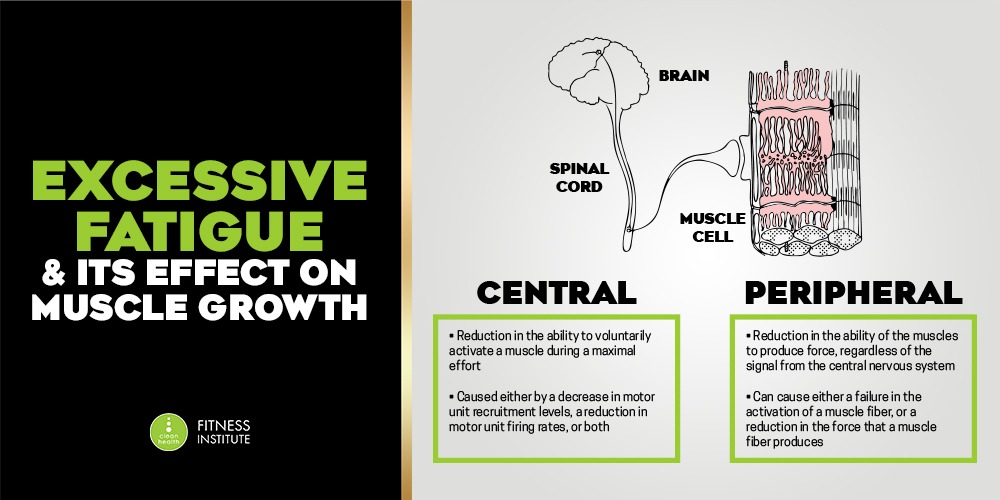
Written by Stefan Ianev (Clean Health Research & Development Specialist)
In past blogs we’ve covered how muscle fibers need to be exposed to sufficient mechanical loading to stimulate hypertrophy. We also discussed how muscle damage and metabolic stress do not directly contribute to stimulating hypertrophy but tend to occur as a by-product of mechanical loading, and too much of either can be detrimental to hypertrophy.
That means we need to find a balance between delivering sufficient mechanical loading to the muscle fibers to stimulate hypertrophy while avoiding excessive muscle damage and metabolite accumulation.
In this blog, we are going to explore in a little bit more detail how muscle damage and metabolic stress can impede hypertrophy.
When we exercise, we often experience a temporary reduction in strength, which is called fatigue. This reduction in strength is caused by both peripheral fatigue, and central nervous system fatigue.
Peripheral Fatigue
Peripheral fatigue refers to a reduction in the ability of the muscles to produce force, regardless of the signal from the central nervous system.
Peripheral fatigue involves 3 processes that occur at the neuromuscular junction including:
- Reduced release of calcium ions from the sarcoplasmic reticulum.
- Reduced sensitivity of the myofibrils to calcium ions.
- Reduced force-producing ability of actin-myosin crossbridges.
These processes can cause either a failure in the activation of a muscle fiber, or a reduction in the force that a muscle fiber produces. Some of these processes involve the accumulation of metabolites inside the muscle fiber, while others do not.
Overall, peripheral fatigue only affects our ability to produce force within a workout and does not affect our ability to produce force for very long following a workout. In addition, peripheral fatigue increases motor unit recruitment to compensate for the reduced force being exerted by the fatigued muscle fibers.

Central Fatigue
Central fatigue is defined as a reduction in the ability to voluntarily activate a muscle during a maximal effort. This reduction in voluntary force can be caused either by a decrease in motor unit recruitment levels, a reduction in motor unit firing rates, or both.
Central fatigue can be measured by an increase in force evoked by nerve stimulation during a maximal voluntary effort. If extra force can be evoked by motor nerve stimulation during a maximal voluntary effort, it indicates that some motor units were not recruited or were not firing fast enough to produce fused contractions at the moment of stimulation (1).
If we are unable to effectively recruit the high-threshold motor units due to central fatigue, we will not be able to impose a mechanical loading stimulus on those fibers and stimulate them to hypertrophy. This means that less muscle growth will be stimulated.
Central fatigue can be both acute, occurring within a workout, and prolonged, lasting several days after a workout. Acutely, it appears that central fatigue within a workout may be caused by metabolite accumulation, an inflammatory response, or a greater cardiovascular demand (2-4).
That is why higher repetitions have been shown to induce greater central fatigue than lower repetitions, contrary to popular belief (5). In addition, shorter rest periods, which are also associated with the accumulation of metabolites, an increased inflammatory response, and an increased cardiovascular demand, have been shown to blunt the anabolic response to resistance training (6,7).

This suggests that we should not be chasing metabolic stress when training to maximize muscle growth, especially early on in a workout, as that could increase central fatigue and impair recruitment of the high threshold motor units. That means training methods aimed at maximizing the ‘pump’ may not be ideal for hypertrophy.
Following a workout, when considered in isolation, the dissipation of peripheral and central fatigue is very rapid after the bout, with the effects lasting less than an hour. However, when muscle damage is present, this changes. Workouts that cause a lot of muscle damage have been associated with central fatigue which persists for much longer than would normally be expected (8).
Several studies have shown that when subsequent muscle damaging workouts are done within several days of the initial workout, muscle damage is not exacerbated, and recovery is not negatively affected (9-11). Some have interpreted this to mean that a higher training frequency may be better for hypertrophy, since the time course for elevated muscle protein synthesis only persists for about 36 hours following a resistance training bout (12).
However, studies have shown that when multiple muscle-damaging workouts are done over a period of several weeks, with insufficient recovery between workouts, minimal hypertrophy occurs (13). This suggests that subsequent workouts are not stimulating hypertrophy, when full recovery has not taken place, indicating that central fatigue may be preventing full motor unit recruitment.
It appears that this central fatigue might be caused by a post-workout inflammatory response involving certain cytokines that enter the brain, which are known to influence fatigue (14,15). In addition, muscle damage can lead to oxidative stress which interferes with the elevation in muscle protein synthesis triggered by mechanical loading (16).
This explains why most bros who try to obliterate each body part at every session, can only train each body part once a week. If they tried hitting a body part any sooner, they would not be fully recovered, and they would not be able to increase their poundages from the previous workout.
A better strategy would be attempting to minimize muscle damage, while still delivering sufficient mechanical loading to the muscles, which would allow you to increase training frequency. Provided a sufficient mechanical loading stimulus has been imposed, and full recovery has taken place before the next session, theoretically, a higher training frequency would yield faster progress.
To learn how to design evidence based training programs safely and effectively, to help you maximize client results with a trialed and tested system that actually works, click here to register for the pre-sale of the Performance PT Coach Certification Level 1 online course!
References
- Taylor JL, Gandevia SC. A comparison of central aspects of fatigue in submaximal and maximal voluntary contractions. J Appl Physiol (1985). 2008 Feb;104(2):542-50. doi: 10.1152/japplphysiol.01053.2007. Epub 2007 Nov 21. PMID: 18032577.
- Siegler JC, Marshall P. The effect of metabolic alkalosis on central and peripheral mechanisms associated with exercise-induced muscle fatigue in humans. Exp Physiol. 2015 Apr 20;100(5):519-30. doi: 10.1113/EP085054. PMID: 25727892.
- Vargas NT, Marino F. A neuroinflammatory model for acute fatigue during exercise. Sports Med. 2014 Nov;44(11):1479-87. doi: 10.1007/s40279-014-0232-4. PMID: 25164464.
- Río-Rodríguez D, Iglesias-Soler E, Fernández Del Olmo M. Set Configuration in Resistance Exercise: Muscle Fatigue and Cardiovascular Effects. PLoS One. 2016;11(3):e0151163. Published 2016 Mar 16. doi:10.1371/journal.pone.0151163
- Behm DG, Reardon G, Fitzgerald J, Drinkwater E. The effect of 5, 10, and 20 repetition maximums on the recovery of voluntary and evoked contractile properties. J Strength Cond Res. 2002;16(2):209-218.
- Henselmans, M., Schoenfeld, B.J. The Effect of Inter-Set Rest Intervals on Resistance Exercise-Induced Muscle Hypertrophy. Sports Med. 2014;44, 1635–1643. https://doi.org/10.1007/s40279-014-0228-0
- McKendry J, Pérez‐López A, McLeod M, Luo D, Dent JR, Smeuninx B, Yu J, Taylor AE, Philp A, Breen L. Short inter‐set rest blunts resistance exercise‐induced increases in myofibrillar protein synthesis and intracellular signalling in young males. Exp Physiol. 2016;101: 866-882. doi:10.1113/EP085647
- Prasartwuth O, Allen TJ, Butler JE, Gandevia SC, Taylor JL. Length-dependent changes in voluntary activation, maximum voluntary torque and twitch responses after eccentric damage in humans. J Physiol. 2006;571(Pt 1):243-252. doi:10.1113/jphysiol.2005.101600
- Chen TC, Nosaka K. Responses of elbow flexors to two strenuous eccentric exercise bouts separated by three days. J Strength Cond Res. 2006 Feb;20(1):108-16. doi: 10.1519/R-16634.1. PMID: 16503669.
- Nosaka K, Newton M. Repeated eccentric exercise bouts do not exacerbate muscle damage and repair. J Strength Cond Res. 2002 Feb;16(1):117-22. PMID: 11834116.
- Chen TC. Effects of a second bout of maximal eccentric exercise on muscle damage and electromyographic activity. Eur J Appl Physiol. 2003 Apr;89(2):115-21. doi: 10.1007/s00421-002-0791-1. Epub 2003 Mar 4. PMID: 12665973.
- MacDougall J, et al. The Time Course for Elevated Muscle Protein Synthesis Following Heavy Resistance Exercise. Canadian journal of applied physiology = Revue canadienne de physiologie appliquée. 1996;20. 480-6. 10.1139/h95-038.
- Krentz JR, Farthing JP. Neural and morphological changes in response to a 20-day intense eccentric training protocol. Eur J Appl Physiol. 2010 Sep;110(2):333-40. doi: 10.1007/s00421-010-1513-8. Epub 2010 May 22. PMID: 20495928.
- Carmichael MD, Davis JM, Murphy EA, Brown AS, Carson JA, Mayer EP, Ghaffar A. Role of brain IL-1beta on fatigue after exercise-induced muscle damage. Am J Physiol Regul Integr Comp Physiol. 2006 Nov;291(5):R1344-8. doi: 10.1152/ajpregu.00141.2006. Epub 2006 Jun 15. PMID: 16778069.
- Goodall S, Thomas K, Barwood M, Keane K, Gonzalez JT, St Clair Gibson A, Howatson G. Neuromuscular changes and the rapid adaptation following a bout of damaging eccentric exercise. Acta Physiol (Oxf). 2017 Aug;220(4):486-500. doi: 10.1111/apha.12844. Epub 2017 Jan 5. PMID: 27981782.
- Takegaki J, Ogasawara R, Tamura Y, Takagi R, Arihara Y, Tsutaki A, Nakazato K, Ishii N. Repeated bouts of resistance exercise with short recovery periods activates mTOR signaling, but not protein synthesis, in mouse skeletal muscle. Physiol Rep. 2017 Nov;5(22):e13515. doi: 10.14814/phy2.13515. PMID: 29180484; PMCID: PMC5704086.






